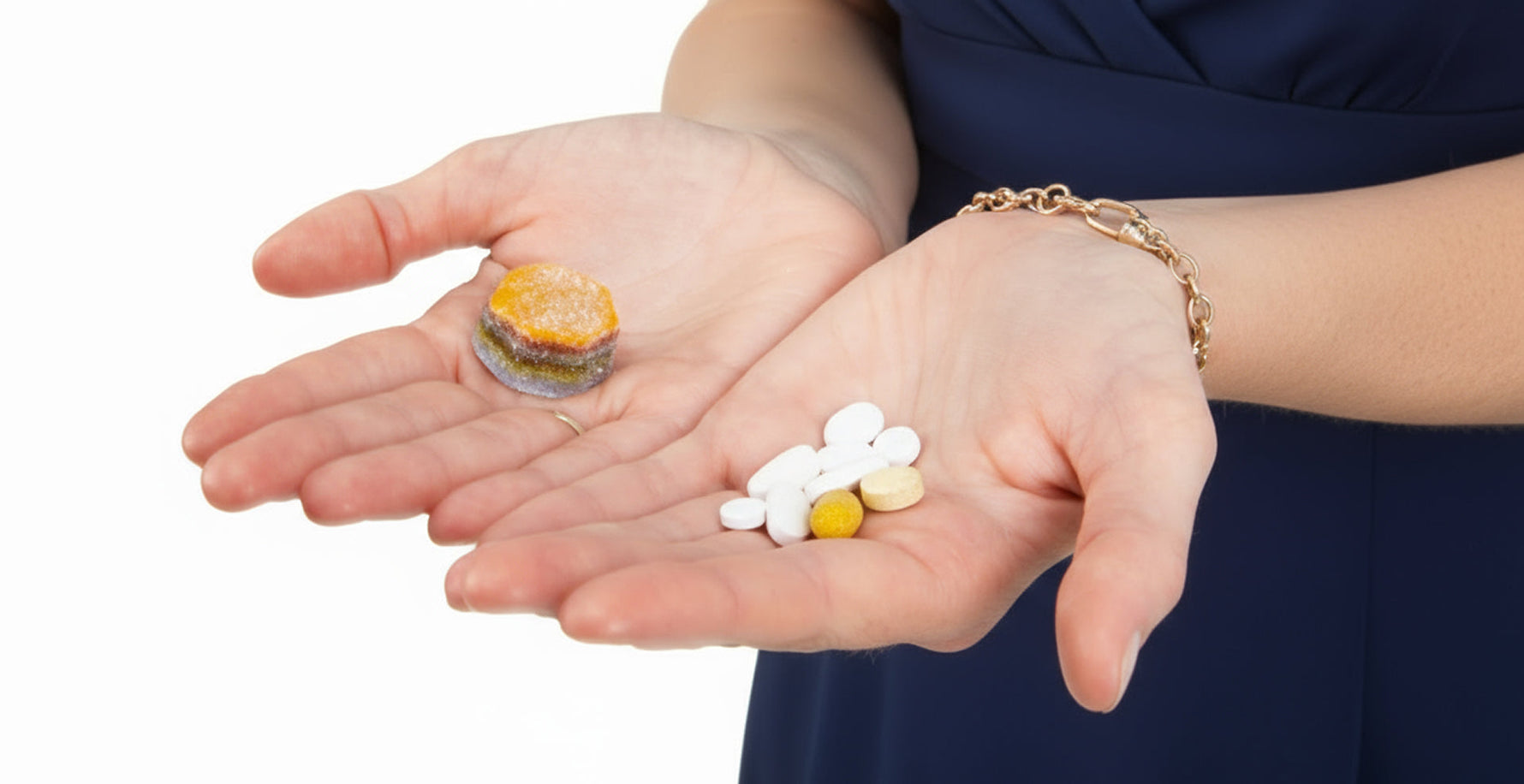Vitamin D insufficiency plagues up to 24% of the US population. Vitamin D is essential for health and can be obtained through a balanced diet, supplements, and exposure to sunlight. This pervasive issue led us to ask: Can gummy supplements match the effectiveness of traditional pills? Our pilot study delves into this question, comparing the impact of gummy vitamins to standard vitamin D pills using the 25-hydroxy vitamin D blood biomarker test as a key indicator.
Objectives
Test the effectiveness of gummy vitamins in raising or maintaining vitamin D serum levels when compared to traditional pills.
Test the likability of gummies as a form of nutrient delivery.
Background
Vitamin D is a group of fat-soluble vitamins responsible for increasing intestinal absorption of calcium, magnesium, and phosphate, and many other biological effects. Vitamin D deficiency is associated with a plethora of health problems, such as weak bones (osteomalacia), autoimmune disorders, poor immune function, muscle weakness and pain, and increased risk of cardiovascular disease and depression. Optimizing vitamin D blood levels (40 - 80 ng/ml of serum vitamin D3) may help prevent and correct some of these morbidities. Given the limited availability of vitamin D in food, supplemental vitamin D offers a convenient and affordable way to correct low serum vitamin D; however, dose, format, and palatability can influence compliance. 54% of newly enrolled members were either severely vitamin D deficient (7%) or insufficient (47%).
The prevalence of vitamin D deficiency (less than 13 ng/ml or < 30 nmol/L) is 6% in the USA, 7% in Canada, and 13% in Europe. Vitamin D insufficiency (i.e. less than 20 ng/ml or < 50 nmol/L) rates have been estimated to be 24% in the USA, 37% in Canada, and 40% in Europe [1,2,3,4,5].
The study
In this study, we designed personalized vitamin D dosing regimens in the form of Gummies (intervention) or softgel pills (control) and monitored intake and compliance via periodic surveys. The dosage was personalized to the member's own needs based on their baseline vitamin D serum levels.
We screened 156 potential candidates for the intervention, and 39 were subsequently enrolled. Both the intervention group and the control group were asked to sample blood by finger prick twice throughout this study: first, before the study (vitamin D baseline), and second, after the 12 weeks of daily Gummy supplementation. A subset of participants was asked to undergo an additional vitamin D assessment via venipuncture blood test before and after the study concluded to validate the finger-prick results. Vitamin D baseline serum level, member’s BMI, and current vitamin D dose (if applicable) were used as inputs to generate personalized vitamin D doses.
Participants in the intervention group received a 12-week daily dose of Gummies containing personalized concentrations of vegan Vita-algae vitamin D3™ and one or more of the following nutrients: vitamin A, vitamin B12, vitamin C, vitamin E, vitamin K2, iron, zinc, selenium, ginseng, ashwagandha, LactoSpore probiotics, CoQ10, inositol, and folic acid. The daily vitamin D dose varied from 1,600 IU to 11,400 IU. The gummies used Nourished Vita-algae vitamin D3, which was sourced from a mixture of algae and lichen fungus species that grow in the northern parts of Canada. The gummies were blackcurrant-flavored.
The control group received generic vitamin D softgels at dosages of 1,000 IU, 2,000 IU, 5,000 IU, 7,000 IU, or 10,000 IU, depending on their baseline serum vitamin D level.
Study visual abstract:
Length of intervention
Participants in the intervention group were instructed to consume one gummy daily for 12 weeks. Those in the control group were instructed to take one personalized vitamin D softgel pill daily for 12 weeks.
Intervention participants
We screened suitable intervention candidates with low vitamin D serum levels. 39 healthy participants with low vitamin D levels at the baseline measurement were selected; they were vitamin D deficient (20 - <40 ng/ml) or severely deficient (10 - <20 ng/ml). In some cases, participants with a history of low vitamin D levels and currently taking vitamin D supplements were also selected to participate. Their current vitamin D supplement was replaced with a gummy supplement that has a closely matching vitamin D dose.
Intervention group inclusion criteria (assessed via a survey):
History of low vitamin D and/or currently on personalized vitamin D supplementation in their supplement plan.
Willingness to do an at-home biomarker test using a finger prick and a dry blood spot card.
Willingness to do an additional vitamin D test via venipuncture at QuestLab or LabCorp
Vitamin D deficient (20 - < 40 ng/ml) or severely deficient (10 - < 20 ng/ml) at baseline
Willing to consume one gummy supplement per day for 12 weeks
Willing to give feedback via survey
Can be overweight or obese
Intervention group exclusion criteria
Those with advanced liver insufficiency, intestinal malabsorption, nephrotic syndrome, liver diseases, cystic fibrosis, Crohn's disease, gastric bypass surgery and/or chronic renal failure were excluded from the intervention group.
Study Results
Gummy supplements had an equal effect to pills
The gummy supplements were equally effective in raising vitamin D serum levels as the personalized vitamin D soft gel pills after 12 weeks of supplementation.
Figure 1. Significant improvement of the 25(OH)D3 blood serum levels of participants before and after supplementation with either the vitamin D gummy (n=22) or vitamin D softgel pill (n=32). The vitamin D gummy supplement group (left) with P value = 0.0016, and vitamin D softgel (right) with P value = 0.0019. Wilcoxon matched-pairs signed-rank test, a non-parametric equivalent of the paired t-test, was used for data analysis.
Majority of study participants preferred gummies to pills
The gummy supplements were a popular alternative to traditional softgel pills, and compliance was high, with 79% of those in the gummy intervention group reporting that they took their gummy supplement daily. Participants enjoyed the gummy supplement’s fun and easy-to-eat format, personalized dose, 3D-printed design, and taste. 63% of the gummy intervention group found the gummies more appealing and enjoyable than taking supplement pills.
“I enjoy and look forward to having my gummy compared to the pills, which are much harder to take.”
Preceding vitamin D gummy vs. pills study
Similarly, a recent study [6] investigated the importance of the formulation and vehicle used for vitamin D supplements in achieving targeted circulating vitamin D levels associated with various health outcomes. The study concluded that vitamin D gummies are absorbed more effectively in the gastrointestinal tract, and could be a more effective option for individuals who struggle with traditional pills.
Summary
The vitamin D gummy supplements were equally effective in raising or maintaining vitamin D serum levels as vitamin D softgel pill supplements. The majority of participants in the intervention group preferred the vitamin D gummy supplement compared to vitamin D softgel pills.
About the author
Zuzana Krejciova-Rajaniemi, PhD, is Luminary Vitamins' science advisor. With a Doctor of Neuroscience degree from the University of Edinburgh, UK, focusing on neurodegenerative diseases and drug discovery, and over 15 years in the field, including work in a Nobel Laureate lab at UCSF, Zuzana possesses a profound understanding of cutting-edge scientific research.
References
[1] Amrein, K., Scherkl, M., Hoffmann, M., Neuwersch-Sommeregger, S., Köstenberger, M., Tmava Berisha, A., Martucci, G., Pilz, S., & Malle, O. (2020). Vitamin D deficiency 2.0: an update on the current status worldwide. European journal of clinical nutrition, 74(11), 1498–1513. https://doi.org/10.1038/s41430-020-0558-y
[2] Cashman K. D. (2020). Vitamin D Deficiency: Defining, Prevalence, Causes, and Strategies of Addressing. Calcified tissue international, 106(1), 14–29. https://doi.org/10.1007/s00223-019-00559-4
[3] Cashman, K. D., Dowling, K. G., Škrabáková, Z., Gonzalez-Gross, M., Valtueña, J., De Henauw, S., Moreno, L., Damsgaard, C. T., Michaelsen, K. F., Mølgaard, C., Jorde, R., Grimnes, G., Moschonis, G., Mavrogianni, C., Manios, Y., Thamm, M., Mensink, G. B., Rabenberg, M., Busch, M. A., Cox, L., … Kiely, M. (2016). Vitamin D deficiency in Europe: pandemic?. The American journal of clinical nutrition, 103(4), 1033–1044. https://doi.org/10.3945/ajcn.115.120873
[4] Schleicher, R. L., Sternberg, M. R., Looker, A. C., Yetley, E. A., Lacher, D. A., Sempos, C. T., Taylor, C. L., Durazo-Arvizu, R. A., Maw, K. L., Chaudhary-Webb, M., Johnson, C. L., & Pfeiffer, C. M. (2016). National Estimates of Serum Total 25-Hydroxyvitamin D and Metabolite Concentrations Measured by Liquid Chromatography-Tandem Mass Spectrometry in the US Population during 2007-2010. The Journal of nutrition, 146(5), 1051–1061. https://doi.org/10.3945/jn.115.227728
[5] Crowe, F. L., Jolly, K., MacArthur, C., Manaseki-Holland, S., Gittoes, N., Hewison, M., Scragg, R., & Nirantharakumar, K. (2019). Trends in the incidence of testing for vitamin D deficiency in primary care in the UK: a retrospective analysis of The Health Improvement Network (THIN), 2005-2015. BMJ open, 9(6), e028355. https://doi.org/10.1136/bmjopen-2018-028355
[6] Wagner, C. L., Shary, J. R., Nietert, P. J., Wahlquist, A. E., Ebeling, M. D., & Hollis, B. W. (2019). Bioequivalence Studies of Vitamin D Gummies and Tablets in Healthy Adults: Results of a Cross-Over Study. Nutrients, 11(5), 1023. https://doi.org/10.3390/nu11051023








